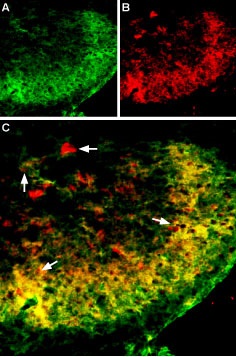Overview
- Peptide (C)GEFGGHDKPKITAWE, corresponding to amino acid residues 106-120 of rat vesicular GABA transporter (Accession O35458). Cytoplasmic, N-terminus.

 Expression of Vesicular GABA Transporter in rat cerebellumImmunohistochemical staining of rat frozen cerebellum sections using Anti-Vesicular GABA Transporter (VGAT)-ATTO Fluor-594 Antibody (#AGT-005-AR), (1:100). A. VGAT staining is shown in red. B. DAPI is used as a general cellular marker (blue). C. Merge of A and B reveal that VGAT is most intensely expressed in the granule and pyramidal layer (arrow).
Expression of Vesicular GABA Transporter in rat cerebellumImmunohistochemical staining of rat frozen cerebellum sections using Anti-Vesicular GABA Transporter (VGAT)-ATTO Fluor-594 Antibody (#AGT-005-AR), (1:100). A. VGAT staining is shown in red. B. DAPI is used as a general cellular marker (blue). C. Merge of A and B reveal that VGAT is most intensely expressed in the granule and pyramidal layer (arrow).
- Gasnier, B. (2004) Pflugers Arch. 447, 756.
- McIntire, S. et al. (1997) Nature 389, 870.
- Bedet, C. et al. (2000) J. Neurochem. 75, 1654.
- Chaudhry, F.A. et al. (1998) J. Neurosci. 18, 9733.
- Dumoulin, A. et al. (1999) J. Cell Sci. 112, 811.
- Takamori, S. et al. (2000) J. Neurosci. 20, 4904.
- Mayerhofer, A. et al. (2001) FASEB J. 15, 1089.
- Chessler, S. et al. (2002) Diabetes 51, 1763.
The superfamily of amino acid transporters includes SLC32, SLC36 and SLC38 families. SLC32 has only one member, the vesicular inhibitory amino acid transporter (VIAAT) or vesicular GABA transporter (VGAT)1.
VGAT is responsible for the uptake of GABA and glycine in exchange of protons, and their release from nerve terminals1.
The transporter is organized into ten membrane spanning domains, a cytosolic N-terminus and a luminal C-terminal tail2. In many regions in the brain, where it is expressed, it is found constitutively phosphorylated, although the biological significance is currently unknown3.
VGAT is expressed on synaptic vesicles of GABAergic and glycinergic neurons4-6. The transporter is also detected in the pituitary gland and in the pancreas7,8.
Application key:
Species reactivity key:
Anti-Vesicular GABA Transporter (VGAT) Antibody (#AGT-005) is a highly specific antibody directed against an epitope of the rat protein. The antibody can be used in western blot, immunohistochemistry, and immunocytochemistry applications. It has been designed to recognize VGAT from human, mouse, and rat samples.
Anti-Vesicular GABA Transporter (VGAT)-ATTO Fluor-594 Antibody (#AGT-005-AR) is directly labeled with an ATTO-594 fluorescent dye. ATTO dyes are characterized by strong absorption (high extinction coefficient), high fluorescence quantum yield, and high photo-stability. The ATTO-594 fluorescent label belongs to the class of Rhodamine dyes and can be used with fluorescent equipment typically optimized to detect Texas Red and Alexa-594. Anti-Vesicular GABA Transporter (VGAT)-ATTO Fluor-594 Antibody has been tested in immunohistochemical applications and is specially suited to experiments requiring simultaneous labeling of different markers.
 Multiplex staining of Vesicular GABA Transporter and Gephyrin in rat spinal cord.Immunohistochemical staining of perfusion-fixed frozen rat spinal cord sections using Anti-Gephyrin Antibody (#AIP-005), (1:300) and Anti-Vesicular GABA Transporter (VGAT)-ATTO Fluor-594 Antibody (#AGT-005-AR), (1:80). A. Gephyrin staining (green) appears in the superficial layer of the spinal dorsal horn and some cellular profiles were stained. B. VGAT staining (red) appears in superficial layer and in cell profiles. C. Merge images of A and B reveals co-localization (arrows) in superficial layers and separate expression in some cells. Cell nuclei were stained with DAPI (blue) as the counterstain.
Multiplex staining of Vesicular GABA Transporter and Gephyrin in rat spinal cord.Immunohistochemical staining of perfusion-fixed frozen rat spinal cord sections using Anti-Gephyrin Antibody (#AIP-005), (1:300) and Anti-Vesicular GABA Transporter (VGAT)-ATTO Fluor-594 Antibody (#AGT-005-AR), (1:80). A. Gephyrin staining (green) appears in the superficial layer of the spinal dorsal horn and some cellular profiles were stained. B. VGAT staining (red) appears in superficial layer and in cell profiles. C. Merge images of A and B reveals co-localization (arrows) in superficial layers and separate expression in some cells. Cell nuclei were stained with DAPI (blue) as the counterstain.
